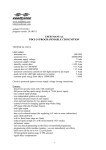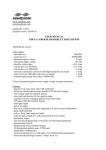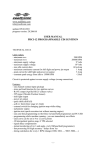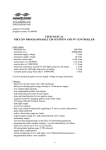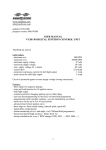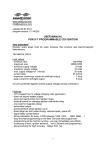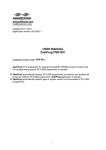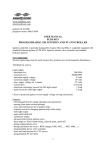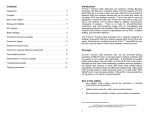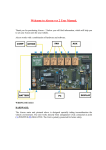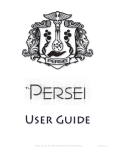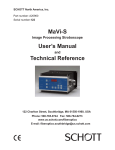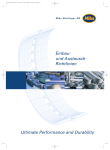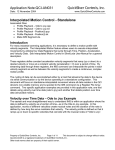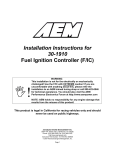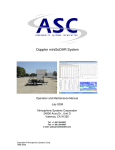Download user manual pdci-30 programmable cdi ignition
Transcript
www.zeeltronic.com [email protected] updated 07.12.2011 program version: 20.111206 USER MANUAL PDCI-30 PROGRAMMABLE CDI IGNITION TECHNICAL DATA Limit values: - minimum revs - maximum revs - minimum supply voltage - maximum supply voltage - stand-by current draw - current draw at 1300 RPM - current draw at 12000 RPM - maximum continuous current for shift light and power jet output - peak current for shift light and power jet output - constant spark energy from idle to 14000 RPM 200 RPM 20000 RPM 7 Volts 18 Volts < 0.05 Amp < 0.4 Amp < 2.4 Amp 1 Amp 5 Amp >35mJ Circuit is protected against reverse supply voltage (wrong connection). Features: - fast power-up - full power starting spark energy already at 7Volts power supply - 3 isolated inputs for pickups - 3 independent ignition coil outputs - individual advance/retard of each output - store and load function for two ignition maps - external switch for changing ignition map while riding - shift light output - power jet output - quick shift (shift kill) - soft rev limit (three stage rev limit) - tachometer output - easy and fast programming on the field, via hand held programmer - PC-USB programming - programming while machine running - you can immediately see effects - each curve can be set in 4 to 12 curve points - signal delay compensation - instant monitoring of rev's and angle, via hand held programmer and PC - timing calculation for every 1 RPM change (1000, 1002, .. , 9805, 9806, ...) -1- Very important! Resistor spark plugs must be used, because they produce less electromagnetic disturbances. Danger of electric shock! Avoid connecting PDCI to 12V power supply, before connecting it to ignition coil. High voltage is generated and touching free wires can cause electric shock, or damage the unit. 1. HOW TO ENTER MENU PDCI must be connected to power supply. Connect programmer to PDCI and wait few seconds for activation of programmer and then press enter. With pressing + or - you can move through menu and with pressing enter you can choose. You can exit menu with choosing Exit. 2. MENU ORGANISATION Load Ign. Map Save Ign. Map Set Ignition Map Advance Advance 1 Advance 2 Advance 3 Gear Shift Light Quick Shift Rev Limit Static Angle Compensation Power Jet 1 Ign. Map SW Nr. of Pickups Ignition Test Exit 3. - load (select) ignition map (from #1 to #2) - save new ignition map (from #1 to #2) - ignition map parameters submenu - advance/retard whole ignition map on both ignition coil outputs - advance/retard ignition coil output 1 - advance/retard ignition coil output 2 - advance/retard ignition coil output 3 - shift light - quick shift settings - rev limit - static angle (stator position) - signal delay compensation (from pickup to spark plug) - power jet 1 - activating/deactivating external switch for selecting ignition map - number of connected pickups - test ignition spark LOAD IGN. MAP Enter menu and move to Load Ign. Map with pressing + or - and then press enter . Now you can select number of saved ignition map, with pressing + or - and then press enter . 4. SAVE IGN. MAP Enter menu and move to Save Ign. Map with pressing + or - and then press enter . Now you can select number to which you want to save your ignition map, with pressing + or and then press enter . -2- 5. SET IGNITION MAP Enter menu and move to Set Ignition Map with pressing + or - and then press enter. ...you entered submenu for setting ignition map. Submenu organisation: Nr. of Points - number of ignition curve points (from 4 to 12) 1) - first ignition curve point 2) - second ignition curve point ... ... ... ... Exit - exit submenu Important! To avoid wrong processing, don't make unreasonable curve course. Every time you make any changes to ignition curve, it is automatically saved to number #0. Later you can save it to any other number #1 or #2. Curve Example with six curve points: 5.1. Change NUMBER OF IGNITION CURVE POINTS Move to Nr. of Points with pressing + or - and then press enter . Now you can select number of ignition points, with pressing + or - and then press enter . -3- 5.2. Change PARAMETERS OF IGNITION CURVE POINT Move to point you want to change, with pressing + or - and then press enter . Now you can change rev point with pressing + or - (in 100 rpm steps) and then press enter . Now you can change advance angle with pressing + or - (in 0.1deg steps) and then press enter . 6. ADVANCE With this setting is possible to advance, or retard whole ignition map on both ignition coil outputs. When setting is positive, then ignition map is advanced and when setting is negative, than ignition map is retarded. Ignition map is unchanged, with setting 0.0deg. Enter menu and move to Advance, with pressing + or - and then press enter . Now you can set advance with pressing + or - (in 0.1deg steps) and then press enter . 7. ADVANCE 1 With this setting is possible to advance, or retard ignition map only on ignition coil output 1. When setting is positive, then ignition map is advanced and when setting is negative than, ignition map is retarded. Ignition map is unchanged, with setting 0.0deg. Enter menu and move to Advance 1, with pressing + or - and then press enter . Now you can set advance with pressing + or - (in 0.1deg steps) and then press enter . 8. ADVANCE 2 With this setting is possible to advance, or retard ignition map only on ignition coil output 2. When setting is positive then, ignition map is advanced and when setting is negative than, ignition map is retarded. Ignition map is unchanged, with setting 0.0deg. Enter menu and move to Advance 2, with pressing + or - and then press enter . Now you can set advance with pressing + or - (in 0.1deg steps) and then press enter . 9. ADVANCE 3 With this setting is possible to advance, or retard ignition map only on ignition coil output 3. When setting is positive then, ignition map is advanced and when setting is negative than, ignition map is retarded. Ignition map is unchanged, with setting 0.0deg. Enter menu and move to Advance 3, with pressing + or - and then press enter . Now you can set advance with pressing + or - (in 0.1deg steps) and then press enter . -4- 10. GEAR SHIFT LIGHT Enter menu and move to Gear Shift Light with pressing + or - and then press enter . Now you can change rev point with pressing + or - (in 100 rpm steps) and then press enter . 11. QUICK SHIFT Enter menu and move to Quick Shift with pressing + or - and then press enter . ...you entered submenu for quick shift settings. Submenu organisation: Shift Kill Time - basic kill time Smart Shift - activating/deactivating automatic kill time for different revs Exit - exit submenu 11.1. SHIFT KILL TIME Enter Quich Shift menu and move to Shift Kill Time with pressing + or - and then press enter. Now you can change kill time with pressing + or - (in 10 ms steps) and then press enter . 11.2. SMART SHIFT Smart shift function automatically adjusts kill time for different revs. Shift kill time must be always set, as basic kill time. Enter Quich Shift menu and move to Smart Shift with pressing + or - and then press enter. Now you can enable, or disable function with pressing + or - and then press enter . 12. REV LIMIT Enter menu and move to Rev Limit with pressing + or - and then press enter . Now you can change rev limit with pressing + or - (in 100 rpm steps) and then press 13. enter . STATIC ANGLE Enter menu and move to Static Angle with pressing + or - and then press enter . Now you can set static angle with pressing + or - (in 0.1deg steps) and then press enter . -5- 14. COMPENSATION It is compensation of signal delay from pickup to spark plugs. You can check this delay with stroboscope lamp. Without this compensation, ignition advance angle decreasing with rising revs. This compensation helps that advance angles in ignition curve are real (more accurate). How to check, if compensation is correct: First you must set flat ignition curve. Then measure with stroboscope lamp, if mark at flywheel moving when changing revs. If mark moving then you must change compensation delay. Change Compensation: Enter menu and move to Compensation with pressing + or - and then press enter . Now you can change compensation delay with pressing + or - and then press enter . 15. POWER JET 1 Enter menu and move to Power Jet 1 with pressing + or - and then press enter . ...you entered submenu for setting Power Jet 1 parameters. Submenu organisation: Power Jet 1 ON RPM Power Jet 1 OFF RPM Exit - revs for activating power jet 1 - revs for deactivating power jet 1 - exit submenu Example: Power jet 1 ON (RPM) = 8000rpm Power jet 1 OFF (RPM) = 10000rpm Power jet is switched on when revs are between 8000-10000rpm, otherwise power jet is switched off. 15.1. POWER JET 1 ON RPM Enter menu and move to Power Jet 1 ON RPM with pressing + or - and then press enter . Now you can change Power Jet 1 ON RPM with pressing + or - (in 100 rpm steps) and then press enter . 15.2. POWER JET 1 OFF RPM Enter menu and move to Power Jet 1 OFF RPM with pressing + or - and then press enter . Now you can change Power Jet 1 OFF RPM with pressing + or - (in 100 rpm steps) and then press enter . -6- 16. IGN. MAP SW Enabling, or disabling ignition map switch, for changing ignition maps while riding. Enter menu and move to Ign. Map SW with pressing + or - and then press enter . Now you can enable or disable external switch with pressing + or - and then press enter . 17. NUMBER OF PICKUPS PDCI can run with 1, or 3 pickups. When using one pickup, then all 3 ignition coils fire at the same time. Enter menu and move to Nr. of Pickups with pressing + or - and then press enter. Now you can change nr. of pickups with pressing + or - and then press enter . 18. IGNITION TEST Spark execution test without running engine. Spark can be optically checked, with removed spark plug connected to plug cup and to the ground. Enter menu and move to Ignition Test with pressing + or - . With pressing enter multiple spark will occur, for about 1s for each output channel. 19. MECHANICAL SETTINGS (Static Angle) Static Angle is ignition advance angle, set with stator (generator). Measure this angle with dial gauge. This measured Static Angle is your maximum advance angle you can set with PDCI. Calculating mm to deg or vice versa: -7- 20. MONITORING Connect programmer to PDCI and wait few seconds for activation of programmer. Fist information displayed on the programmer is software version. With programmer you can watch revs, calculated advance ignition angle, TPS position...depends on setting in the menu. Information! You can connect or disconnect PDCI unit from programmer any time you want, without any harm. It is not important, if motor running or not and if power supply is connected or not. Important! Do not use too much force when connecting or disconnecting programmer unit! -8- www.zeeltronic.com [email protected] How to measure static angle? The most accurate procedure is with dial gauge. Apply to single and multiple cylinder engines. Necessary tools: - stroboscope light - dial gauge Follow the procedure: Ö measure approximate static angle, just to have starting point...look at drawing below. Anticlockwise rotation: TDC static angle TRIGGER POINT Clockwise rotation: TDC static angle TRIGGER POINT 0,5mm Ö program CDI with measured approximate static angle Ö program CDI with flat ignition curve...16deg advance is suitable for most engines. Ö find information about engine stroke and conrod length Ö convert programmed flat ignition advance angle to millimetres Example: α =16deg (ignition advance) L=110mm (conrod length) R=54/2=27mm (engine stroke divided by 2) T=1,3mm (calculated ignition advance in mm) Equation for calculating from degrees to millimetres: α = ignition advance in degrees T = ignition advance in mm R = engine stroke divided by 2 in mm L = conrod length in mm T = L + R ⋅ (1 − cos α ) − L2 − (R ⋅ sin α ) 2 Ö remove sparkplug from cylinder head and place dial gauge Ö find TDC (Top Dead Centre) Ö rotate engine backwards (opposite from engine running rotation) to calculated advance in millimetres (in example is 1,3mm) and make marks on rotor and stator Ö remove dial gauge and place sparkplug back to cylinder head Ö start engine and run with constant revs of about 3000rpm, or 4000rpm Ö use stroboscope light to check, if marks on rotor and stator align Ö adjust static angle with programmer to align marks on the rotor and stator Result of above procedure is very accurate static angle.










